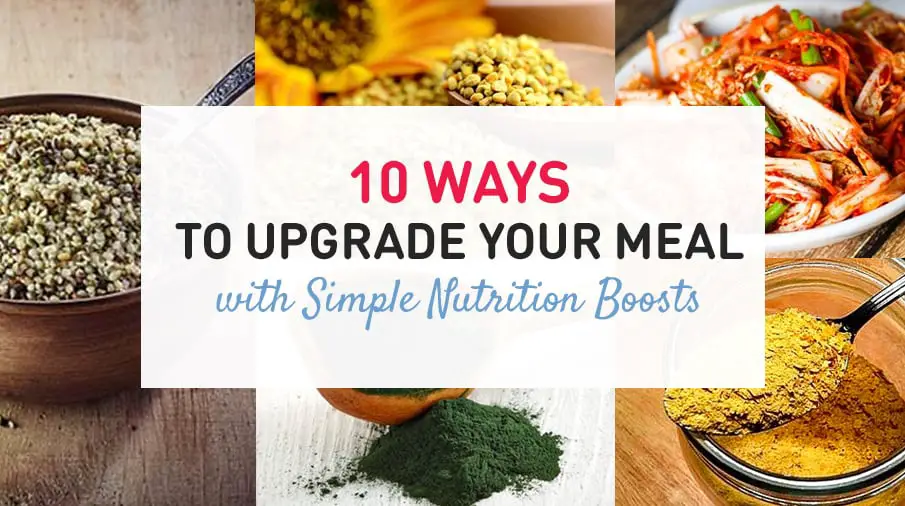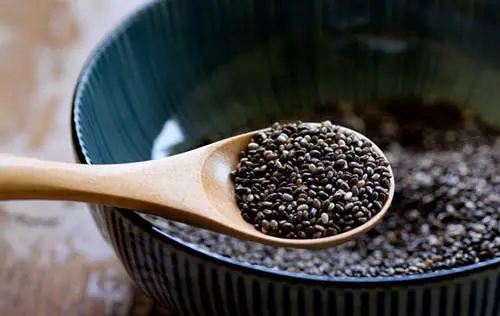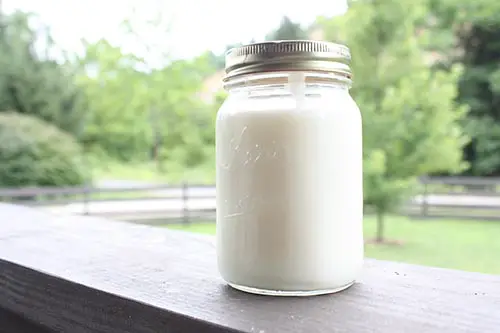Medically review by Kim Langdon


I don't know about you, but we're always searching for ways to up the nutrition and taste of the food we're eating.
Besides eating a balanced diet mainly consisting of real food, we're on the hunt for those little things that make a big impact.
Many times, these so-called superfoods are easy additions to what we're already eating, and that's what we want to talk about.
These easy add-ins can become daily staples in your diet that you'll grow to love and enjoy.
They'll max the nutrition in your meals and maybe even take the flavor up a notch, giving it the kick you need.
Dulse


What it is: Dulse is a type of seaweed which makes it inherently healthy for you. This seaweed is generally red in color, and it has a slightly spicy flavor making it a tasty addition to many savory meals.
Why you should eat it: It contains high amounts of vitamins B6, B12, A, Iron, Potassium, Phosphorus, and Manganese. Dulse helps to support both a healthy digestive system and healthy brain. Finally, it can cleanse the body of heavy metals making it a vital choice for a detox food.
How to use it: Dulse can easily be sprinkled onto savory dishes. Try adding it to your salad at lunch for a kick of mild and smoky flavor.
You can often purchase dulse in a shaker like salt so it is easily incorporated for a regular superfood boost. You can even use it as a natural salt replacement during cooking.
Chia seeds


What it is: These little seeds are packed with energy, and chia is derived from the Mayan word "strength."
They're related to the mint family. They can be found whole or ground. The fibrous whole seeds gel up when mixed with liquid making them satiating due to their expansion.
Why you should eat it: Chia seeds are a powerhouse. They contain omega-3's, loads of B vitamins, calcium and iron.
Per one-ounce serving, you'll get a whopping 11 grams of fiber making these great for a satiating addition to your food. Their high antioxidant load fights free radicals, and they're one of the highest quality plant proteins out there.
How to use it: If you like smoothies, you might try adding in a tablespoon or two of chia seeds. This will give you an energizing morning boost and keep you feeling full.
Alternatively, those sensitive to eggs can use chia seeds as a substitute for binding. Simply mix 1 tablespoon to 3 tablespoons of water and let sit until it gels.
Spirulina


What it is: Spirulina is often sold as a deep green colored powder. This powder is technically a cyanobacterium, otherwise known as blue-green algae hence its saturated hue.
Why you should eat it: Spirulina is touted as one of the world's healthiest foods and for good reason. A little bit goes a long way. It's a dense source of B vitamins, vitamin K and vitamin E. 100 grams of the stuff will give you 219% of your daily iron intake.
Because it is a complete plant protein, it contains all of the essential amino acids.
Finally, the antioxidants found in spirulina have been found to reduce high cholesterol and increase exercise performance.
How to use it: Spirulina can easily be added to dips (as long as you don't mind the green!).
Next time you make fresh guacamole, add a tablespoon or two for a superfood boost. You won't even taste the difference.
Raw cacao


What it is: Raw cacao is simply chocolate before it's all tossed up with sugar and packaged in bars.
Raw cacao powder and nibs are derived from the cacao plant, and they often have a rich but bitter taste.
Why you should eat it: When people talk about how healthy chocolate is, they're referring to the health benefits and high antioxidant load found in raw cacao products.
With healthy fats (oleic acid), the ability to balance hormonal swings (give into those PMS cravings!), and protective benefits for the heart, raw cacao is one healthy way to indulge your chocolate cravings.
Moreover, cacao contains MAO inhibitors boosting serotonin and can be a natural aphrodisiac. Consider it a "happy food."
How to use it: Steer away from sweet and enter savory. Raw cacao powder makes a lovely addition to a bolognese sauce to develop a deeper and more complex flavor.
You can also add it to chili or stew with warm spices like cinnamon and allspice.
Kefir


What it is: Kefir is a fermented milk product produced from kefir grains. It's much like yogurt, except it's generally "drinkable" with similar probiotic content and good bacteria.
Why you should eat it: We're big proponents of probiotics, so squeezing it into your diet is much encouraged!
Kefir will give you natural protein and a calcium boost. So, why don't we just suggest yogurt?
Well, kefir contains about 30 different strains of bacteria making it one of the most powerful probiotic foods which can help digestion and weight management.
It's also thought to be anti-bacterial which makes it a fantastic gut-healing food. Oh, and it's often tolerated well by those who can't have dairy otherwise!
How to use it: Opt for a splash in your smoothie. Cut your liquid of choice in half by adding in 1/2 cup of kefir instead for a creamy and healthy morning boost.
Nutritional yeast


What it is: Nutritional yeast - also known as savory yeast - is a deactivated yeast that tastes a lot like cheese. Yes, CHEESE. You can likely find it amongst other seasonings or in the bulk food section.
Why you should eat it: Nutritional yeast is a great source of B vitamins - in fact, just a 1/2 tablespoon can provide you with a day's worth of 'em!
Despite being a type of deactivated yeast, it doesn't contain Candida albicans which can irritate some people.
Its compounds beta-1,3 glucan, trehalose, mannan, and glutathione are often associated with improved immunity, reduced cholesterol levels, and cancer prevention.
How to use it: If you don't dig dairy, nutritional yeast can add the cheesy taste you're missing out on. Try it on top of bolognese and noodles or a "cheesy" cauliflower and broccoli bake.
Bee pollen


What it is: Bee pollen is just what it sounds like! This food of the young bee is comprised of 40% protein and contains nearly all nutrients required by humans.
Why you should eat it: This stuff contains more amino acids than beef, eggs or cheese in terms of concentration; while you won't eat as large a portion of bee pollen as you would beef, it's still a nutrient-dense addition to your daily routine.
The B vitamins can naturally enhance energy, its anti-inflammatory properties are especially helpful to the respiratory system, and pollen reduces histamine for a natural allergy fighter.
Lastly, bee pollen can help ease cravings.
How to use it: Have a spoonful sprinkled on a banana with some cinnamon or nut butter. The mild taste will give you a morning boost of B vitamins and plant protein with a vibrant pop of color.
Hemp seeds


What it is: These seeds are a complete plant protein, often sold whole or in protein powder form. Of all plant foods, they have the most concentrated source of proteins with a dose of healthy fats to boot.
Why you should eat it: Besides being a great source of protein - particularly for those who are sensitive to dairy - hemp seeds offer loads of nutrition.
Their protein is easily digested, their essential fats contain both omega-3's and omega-6's, and they provide you with all essential amino acids.
They're rich in vitamin E and make a great hypoallergenic source of seeds for those with nut sensitivities. Edestin - a protein found in hemp - can help aid digestion.
Finally, their anti-inflammatory properties can be beneficial to those with arthritis, cardiovascular disease, and even psoriasis.
How to use it: Sprinkle hemp seeds on a salad for a burst of nutty flavor or add a few tablespoons to your post-workout smoothie for a burst of plant-based protein.
You can opt to use hemp protein powder if you're sensitive to whey protein.
Kimchi


What it is: Kimchi is a fermented vegetable dish popular in Korean cuisine. It generally contains napa cabbage, daikon radish, carrots, and lots of red chili flakes giving it a spicy and pungent flavor.
Why you should eat it: Kimchi is a natural source of probiotics and good bacteria due to the fermentation process.
Fermented foods can help heal leaky gut, normalize digestive issues, and up your immunity by keeping bad bacteria in the body at bay.
Since this food is generally quite spicy, you can enjoy the effects that spicy food has on speeding up your metabolism.
How to use it: Stir some into a bowl of quick rice or cauliflower rice with chicken thighs or sliced beef. You can use it as a condiment or have 1/4-1/2 cup as a side dish at any meal.
Turmeric


What it is: Turmeric is derived from a root - often found in powder form - related to the ginger family. It's a bright yellow and it's often found in Thai foods like curry and has been used in Asia for thousands of years.
Why you should eat it: Turmeric is widely known for its anti-inflammatory properties and its medicinal uses are being studied more and more.
Turmeric has been proven as effective as aspirin for chronic inflammation and pain in some people, used to treat depression, and can even inhibit the growth of cancer cells. Turmeric can even help keep your brain sharp and improve memory.
How to use it: For a savory dish, try this Vietnamese turmeric fish and use black pepper as well which helps the body to utilize the anti-inflammatory properties.
For a sweeter option, make some golden milk by adding a dash to a warm mug of coconut milk and a bit of honey.
What's your best-kept secret when it comes to boosting your nutrition? Share how your little goes a long way!
This article was fact checked for accuracy by Dr. Kim Langdon, MD. As always, this is not personal medical advice and we recommend that you talk with your doctor.
References
Share on Pinterest


Kimberly Langdon M.D. is a retired University-trained obstetrician/gynecologist with 19-years of clinical experience. She delivered over 2000 babies to mothers in a suburban Midwestern community.

Thank you for this guide. I have wondered about several of these “add-in’s” like chia seeds (which were in my refrigerator already), but didn’t know what to do with them or even if they were really helpful or just a “fad”.
Absolutely. Some are definitely worth sprinkling in 🙂
I guess I’ve some issue with my gut. The moment I get anxious, my stomach gets upset. ALWAYS. Can any food help with it. Also, what is it?